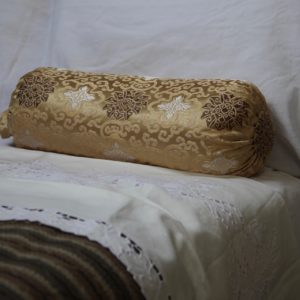Image form Calluna: Cushions – Heather Luke
In furnishing terms, the word of bolster as the description of a cushion, head rest or pillow, refers to a long, narrow, cylindrical pad and cover. Bed and garden bolsters tend to be used, so informal, welcoming and washable. Sofa bolsters are almost always designed for the look of them and for how they make a sofa or day bed look, before considerations of comfort; in fact they can be designed deliberately to create a barrier or protection between a seat and an end of something. They can be of any material, and when they act as the arms of an armless bench or sofa, or become the soft section next to a wooden side they are often covered with the same fabric as the main upholstery. Trimmings can be elaborate, and at least a piping or a rosette and tassel.
There are two types of bolsters:
1. Traditionally lying across the full width of the head of a bed, either to support a softer downy head pillow, or as the only head rest and stuffed with anything from herbs to straw to fine feathers, down, fleece or recycled clothing, depending on locality and budget. Typically, the covers were made from plain weave cotton or linen,which is easy to launder and available.
2. As ‘arms’ for armless chairs, and as soft side cushions for show-wood furniture with thinner upholstered arms; the arms were sometimes specifically shaped to accommodate the round shape of a bolster. These bolsters are for decoration before comfort and tend to be trimmed with tassels and cartouche.
Image form Calluna: Cushions – Heather Luke
From the vast site of the Dambulla cave complex in Sri Lanka. The caves date to 2nd – 3rd century BC with various works since and particularly in the 12th century. This rather beautiful sculpted and painted version implies that bolsters as seats and places of comfort have ben around for a very long time, respected and the recipient of the best off textiles and trimmings. Any re-painting and restoration will have been carefully considered and executed to replicate the previous colourings.
Image – Heather Luke Dambulla.
https://en.wikipedia.org/wiki/Dambulla_cave_temple



